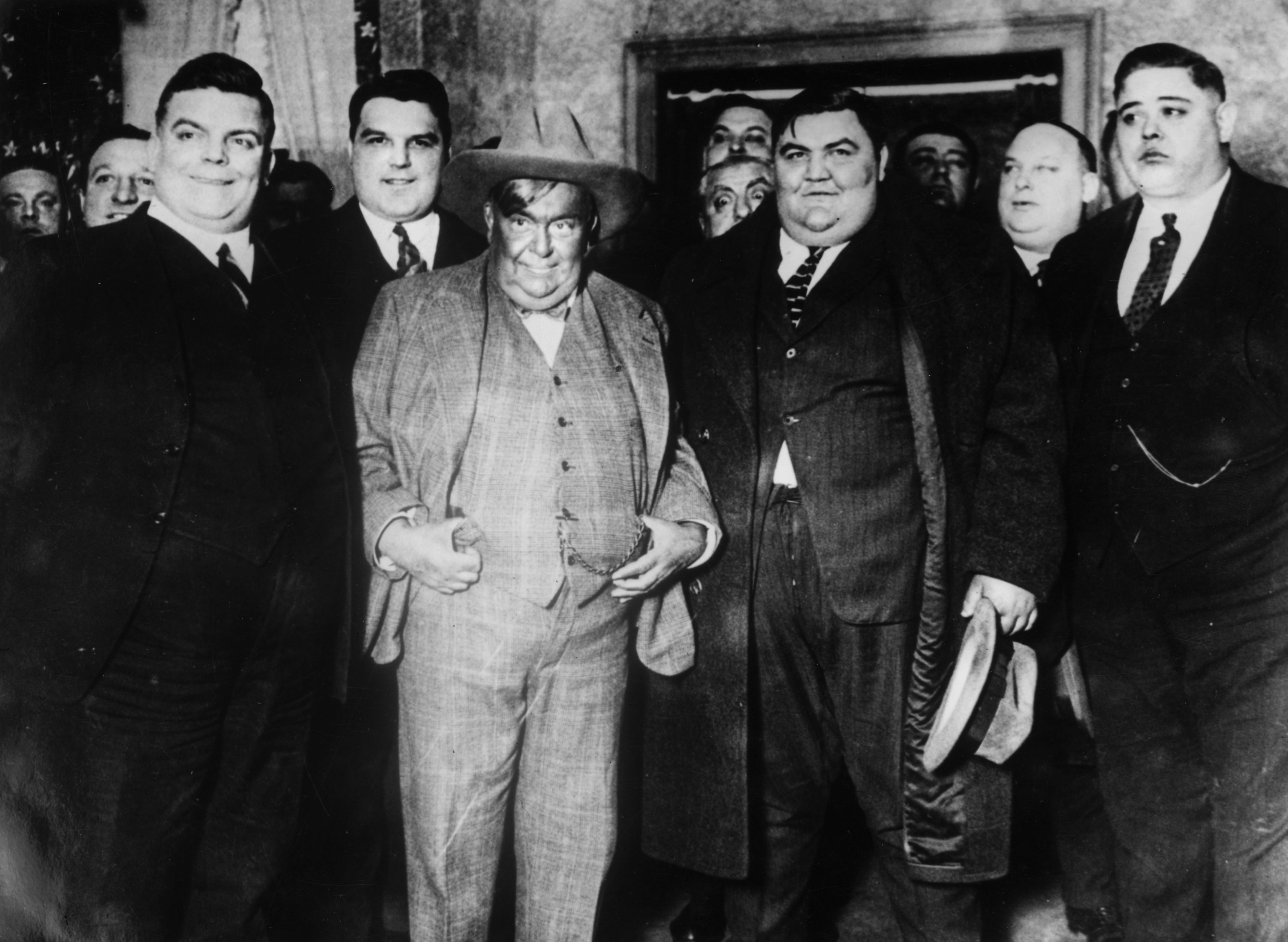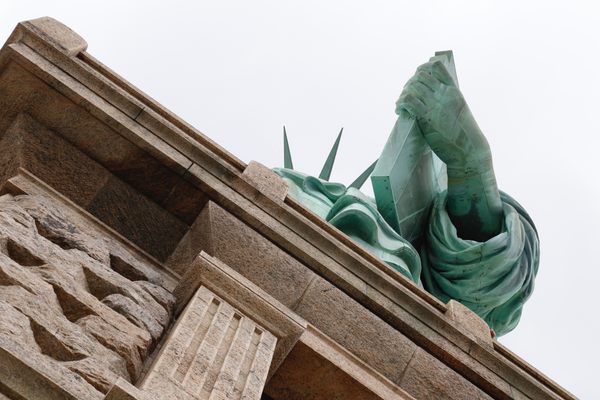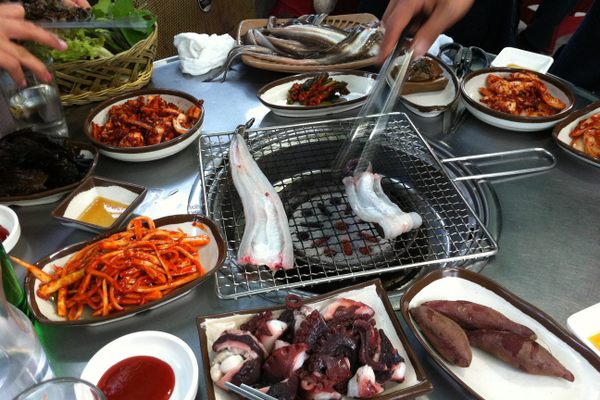The Fat Men’s Clubs That Revelled in Excess
In 19th-century America, cultural anxieties led to groups where fat was fun.

On a bright August day in 1884, a group of men gathered near Long Island Sound. They arrived in boats that nearly capsized, wagons pulled by heaving horses, and streetcars where no room was left for conductors to walk between the rows. It was the annual clambake of the Connecticut Fat Men’s Club.
In the New York Times, a journalist reverently wrote of the club’s president, “Mr. Dorlon is huge, he is ponderous, his obesity borders on the infinite, and the most hardened lean man cannot gaze upon his magnificent proportions without being unconsciously made purer and holier.” The event chef, “an artist in clams” from Brooklyn, baked 60 bushels of clams atop hickory logs (that is between 6,000 and 24,000 clams, depending on what kind was being cooked). Also on the menu were “wagon loads of happy Spring chickens, boat loads of cheerful lobsters, and crates of green corn and vegetables.” The whole lot was covered in seaweed and slow-cooked for hours.
Upon conclusion of the feast, there was a weigh-in, followed by a final speech by Dorlon, who, holding the club’s ceremonial golden staff with the weights of his presidential predecessors inscribed on it, wept at his comparative slenderness and offered to relinquish his presidency to a worthier, more weighty representative. He was unanimously re-elected.
The Connecticut club was no anomaly. At the time, fat men’s clubs—cheery celebrations of excess, where members rejoiced in each other’s weighty presence over elaborate meals—sprung up all over the East Coast. Kerry Segrave, in his book Obesity in America, 1850-1939: A History of Social Attitudes and Treatment, explains that the clubs existed alongside contradictory discourses around obesity. While some commentators decried the mental and physical degeneration that they alleged was caused by obesity, other accounts venerated the good spirits and utter lack of criminality among the generously endowed.
The general tenor around plumpness seemed to oscillate between viewing fat men as upstanding leaders of society enjoying wealth and social status, and regarding them as freaks to be fetishized at carnival sideshows. Fat men were considered virtuous, good-natured, and morally upright. Or, as an 1877 editorial in the New York Times, which Segrave cites, unkindly described the clubs’ members: “The fat man is a mystery to himself, and his vague groping after his correct solution are shown by his practice of associating himself with other fat men in clubs, and performing Herculean feats of public overeating.”
But the clubs appeared unconcerned by the debate, or even motivated by it. New York was evidently bulging with fat men’s clubs, and may have had the first such organization in the Fat Men’s Association of New York City, formed some time in the 1860s. The Brooklyn Daily Eagle archives mention the Fat Men’s Association of Coney Island, whose annual ball was quite the shake-up. All fat men’s clubs events featured a weigh-in, with pigs given out as prizes to the heaviest members. News reports describe members stuffing pillows under their vests and coins in their pockets in desperate bids to tip the scales.

Conspicuous consumption was not the only abiding diversion at these clubs. Another New York Times piece from 1885, titled “Too Much for Flushing,” describes a baseball game between the fat men’s clubs of Brooklyn and Flushing: “The individual masses of rotund corpulency made up the famous Fat Men’s baseball nine of Brooklyn, and they had gone down with all the speed they were capable of to test the agility of a similar set of linear and latitudinal giants from Flushing.” The event was evidently well-attended, with a speech given by a heavyweight among the Brooklyn players, who declared he had to pay a boy 25 cents to help him put his uniform on, and another quarter to take it off.
At least some clubs had specific requirements for joining. A write-up of the first meeting of the Fat Men’s Bicycle Club in Bedford-Stuyvesant, Brooklyn, noted that members had to weigh at least 250 pounds, and women were not allowed. Another club rule held that any member caught eating the notoriously stinky limburger cheese would have to treat the entire club as punishment.
In 1904, the Lewiston Evening Journal covered a basketball game between the Fat Men and the Professional Men in Livermore Falls, Maine. The game was so well-attended that when the teams took position to play, “the cheering was deafening.” An NPR article on fat men’s clubs notes that they expanded to areas including Nevada, Utah, and Tennessee, even crossing over to France, which had its own 100 Kilos Club: Les Cents Kilos.
The menus of the fat men’s clubs offer a look at what wealthy gastronomes were enjoying. The oyster roasts and magnificent barbeques of the Texan clubs were crowning achievements of gustatory overindulgence. In its heyday, the New England Fat Men’s Club, founded in 1903, had over 10,000 members who dined on oyster cocktail, cream of chicken soup, boiled snapper, filet of beef with mushrooms, roast chicken, roast suckling pig, shrimp salad, steamed fruit pudding with brandy sauce, cakes, cheese, and ice cream, with coffee and cigars to finish.
But by 1924, membership numbers had fallen below 38, reflecting a change in attitudes towards fatness, with medical practitioners stressing the benefits of a lean physique.
An analogous development was the decline of fat men’s races, which had been an integral part of American police department outings in the mid-19th century. Segrave writes in Obesity in America that by 1908, police force policies required that applicants weigh no more than 250 pounds. In 1910, a former police captain in New York sued after being laid off for his obesity. He was reinstated only after demonstrating to a jury that he could hop, skip, and jump as well as anybody else. By 1916, “excessive obesity” became a disqualifier for anyone applying to civil service jobs in New York.
Although fat men’s clubs had been popular, they always existed alongside a discourse privileging thinness. By the 1870s, medical journals mention people who wished to Bantingize, referring to a low-carb diet plan invented by the English dietician and undertaker William Banting. But while they were still in operation, the fat men’s clubs thumbed their nose at moderation and negative body image, in favor of a jolly good time.
Gastro Obscura covers the world’s most wondrous food and drink.
Sign up for our email, delivered twice a week.
























Follow us on Twitter to get the latest on the world's hidden wonders.
Like us on Facebook to get the latest on the world's hidden wonders.
Follow us on Twitter Like us on Facebook